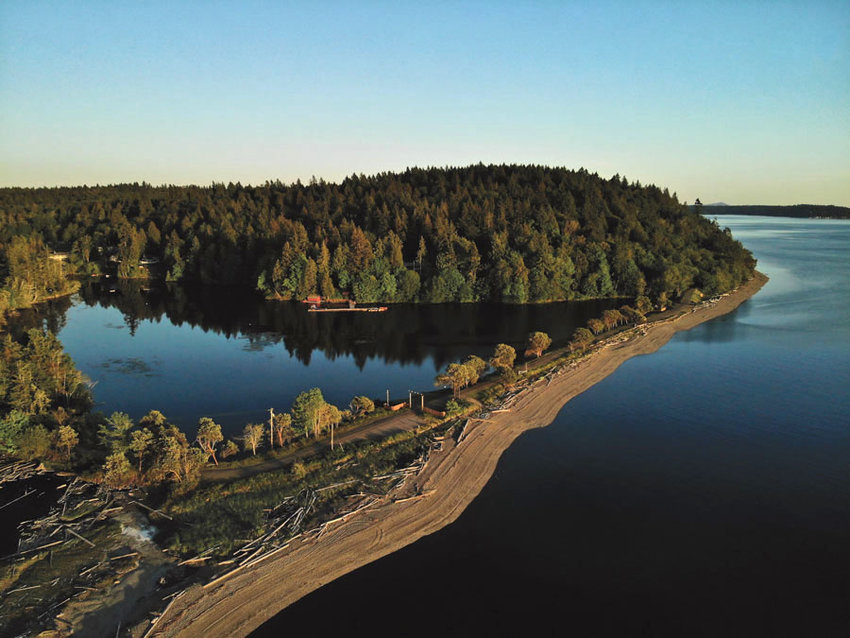 A bird’s eye view of Whiteman Cove. Photo: Chris Konieczny, KP News
A bird’s eye view of Whiteman Cove. Photo: Chris Konieczny, KP News
Restoration of the cove on the west of the Key Peninsula would provide salmon access to a 29-acre pocket estuary with 1.5 miles of shoreline and 1 mile of freshwater spawning and rearing habitat. Not everyone is happy about it.
If Washington state gets its way, the placid waters of Whiteman Cove will someday disappear with the tide.
Neighbors and property owners along Whiteman Cove received an invitation to meet with representatives of the Department of Natural Resources March 19 in the Brones Room at the Key Center Library.
The gathering was part of DNR’s early outreach to stakeholders to begin discussion of Whiteman Cove habitat restoration and focused on a fish passage barrier identified for removal under a 2013 U.S. District Court order.
Whiteman Cove is located on the west side of the Key Peninsula, sandwiched between Joemma Beach State Park to the north and YMCA Camp Colman to the south. Single family homes surround the cove and overlook a peaceful saltwater lagoon, or lake, as the DNR calls it.
“We spent most of the meeting with the community discussing concerns and soliciting recommendations for the restoration work design,” said Joanna Eide, legislative director for DNR, in a memo apprising state legislators from the 26th District.
“Generally, the issues expressed by the meeting attendees included the conversion of the lake to a tidally influenced estuary, effects on property values, boat access to Case Inlet, and access to Camp Colman,” she wrote.
“The first step is for DNR to solicit bids to contract for the development of architectural and engineering designs for the project,” according to Eide. “DNR estimates the time to complete the restoration will take between two to four years.”
John Lester, president of the Whiteman Cove Homeowners Association, said “DNR showed us five different plans, two of which would include keeping the water in here and doing fish ladder-type things; a 40-foot wide opening; a 60-foot wide opening; (and) going all the way back to natural with a 200-foot long bridge going to the camp,” Lester said. “One way or another Camp Colman would need a bridge or a new road to access the property.”
A private road, owned and maintained by the Whiteman Cove Homeowners Association, leads to the back of the camp.
Lester said he has a number of concerns about the DNR proposal, coupled with pressure from YMCA to allow Camp Colman to use the association’s private road. He and his wife have lived on the cove for 20 years.
“The relationship between the HOA and the camp has seen ups and downs,” he said. “In November 2018, the association installed a locked gate, with a fire lock for emergencies, to prevent YMCA Camp Colman from using the privately maintained road without express permission.”
In a letter dated April 29 addressed to Whiteman Cove homeowners, Senior Executive Director of Camping for the Greater Seattle YMCA Meredith Cambre wrote:
“The YMCA intends to mount a vigorous challenge to the DNR plan, with the goal of identifying alternatives that would benefit salmon without destroying the lagoon…thus far the YMCA has engaged attorneys and is in the process of selecting experts who can assist in this effort.
“As part of developing a united front, we would also like to resolve any differences with the association over use of the road leading to the back entrance of Camp Colman,” she wrote.
In 1962, the Washington State Department of Fisheries converted the 29-acre Whiteman Cove estuary into a lagoon for rearing young salmon as part of its hatchery program. The conversion included closing the natural tidal entrance to the lagoon with fill and installing two large culverts with structures to control the flow of tidal water to maintain water levels.
Fisheries stopped using Whiteman Cove as a salmon-rearing facility after 1970 but left the culverts and tide gates in place. A roadway over the filled entrance provides the only open access to Camp Colman.
Whiteman Cove was identified as a high priority project for nearshore restoration by the South Puget Sound Salmon Enhancement group, a local voice for regional salmon recovery that sponsored the initial scope of restoration and feasibility studies.
“First and foremost, we want to keep the water,” Lester said. “This is just the beginning stages, nothing has been decided yet, but whatever happens––we’re all going to know well in advance.”
Twenty-one Washington tribes, joined by the United States, asked the U.S. District Court in January 2001 to compel the state to repair or replace culverts that impede salmon migration.
In 2007, the district court sided with the tribes’ contention that building and maintaining culverts diminished the size of salmon runs, violating the state’s treaty obligations.
In 2013, the U.S. District Court ordered the state to increase the rate of removal of state-owned culverts and replacement of culverts that adversely impact salmon habitat by 2030.
The state appealed to the Ninth Circuit Court of Appeals, which delivered a unanimous decision allowing the U.S. District order to stand.
Attorney General Bob Ferguson appealed that decision to the U.S. Supreme Court. The Court rendered a split decision June 11, 2018—a tie vote that was a win for the tribes and ended the 17-year-long legal battle.
UNDERWRITTEN BY THE FUND FOR NONPROFIT NEWS (NEWSMATCH) AT THE MIAMI FOUNDATION, THE ANGEL GUILD, ADVERTISERS, DONORS AND PEOPLE WHO SUPPORT INDEPENDENT, NONPROFIT LOCAL NEWS